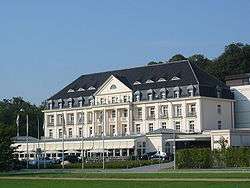Travemünde


Travemünde (German: [ˈtʁaːvəmʏndə]) is a borough of Lübeck, Germany, located at the mouth of the river Trave in Lübeck Bay. It began life as a fortress built by Henry the Lion, Duke of Saxony, in the 12th century to guard the mouth of the Trave, and the Danes subsequently strengthened it. It became a town in 1317 and in 1329 passed into the possession of the free city of Lübeck, to which it has since belonged. Its fortifications were demolished in 1807.
Travemünde has been a seaside resort since 1802, and is Germany's largest ferry port on the Baltic Sea with connections to Sweden, Finland, Russia, Latvia and Estonia. The lighthouse is the oldest on the German Baltic coast, dating from 1539. Another attraction of Travemünde is the Flying P-Liner Passat, a museum ship anchored in the mouth of the Trave.
The annual Travemünder Woche is a traditional sailing race week in Northern Europe. The annual Sand festival in Travemünde is known as the Sand World.
Literature
The 19th century seaside resort was evoked by Thomas Mann in Buddenbrooks. In Part II/5-12 the vacation of Antonie Buddenbrook is told, while in Part X/3 one summer of little Hanno. Travemünde is depicted by Mann as a place of freedom, happiness and - in the case of Antonie - love, in contrast with the problems of everyday life.
Photo gallery
 Kurhaus hotel, designed by architect Joseph Christian Lillie
Kurhaus hotel, designed by architect Joseph Christian Lillie Mouth of river Trave
Mouth of river Trave Casino building, now Columbia hotel
Casino building, now Columbia hotel Lübeck-Travemünde Strand station, displaying the time of the next Lübeck train
Lübeck-Travemünde Strand station, displaying the time of the next Lübeck train- The fountain field, only 200 meters from the railway station, marks the beginning of the promenade
- Excursion boats and roofed wicker beach chairs
- View of the town from the Trave promenade
- The shopping street Vorderreihe
- The bailiff's residence from 1551, one of the oldest buildings in town
- View from the boardwalk, beach and Columbia hotel (the former Casino building)
 Ancient houses and the tower of St Lorenz Church
Ancient houses and the tower of St Lorenz Church Cruise ship at Ostpreussen Quay, close to the Vorderreihe promenade
Cruise ship at Ostpreussen Quay, close to the Vorderreihe promenade
| Wikimedia Commons has media related to Travemünde. |
External links
| Wikivoyage has a travel guide for Travemünde. |
- Travemünde
- Official tourism site
- Travemünde Panoramas
- Travemünde related Photography Blog
- Historical footage of Travemünde, 1919, filmportal.de
Coordinates: 53°58′N 10°52′E / 53.967°N 10.867°E